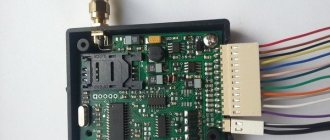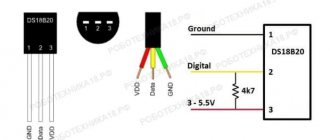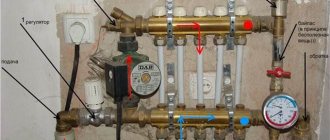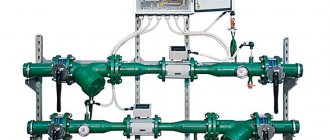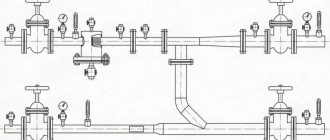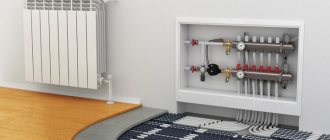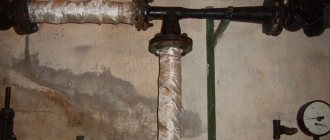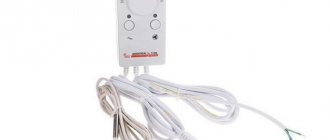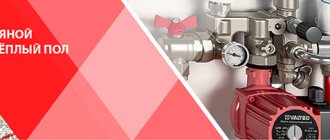An automated heating control unit will help you solve two problems:
- ensure optimal temperature inside the building and
- reduce heating costs.
In our review of heating system control units you will learn:
- When is it advisable to install a weather control unit - examples and calculations
- How does the heating control unit work?
- The main advantages of installing an automated heating control unit
- How to install an automated heating system control unit
- Effective use of automated metering units
- conclusions
Automated heating control unit
How it works
The operating principle of the heating system control unit is very simple:
When the outside temperature drops, for example to -20 °C, the heating control unit supplies more heat to the rooms, thereby maintaining the indoor temperature at the required level, for example +20 °C.
And vice versa.
When the outside temperature rises, for example to +5 ° C, the weather control unit, as it is also called, supplies less heat to the premises.
Thus, heat consumption is reduced, and the temperature in the rooms remains at the level we need, for example, +20 ° C and does not increase to +28 ° C, as often happens during sudden warming.
The temperature does not rise to +28 °C
And scientifically speaking, the weather control unit is designed to ensure and maintain the required coolant temperature in the supply pipeline, depending on the outside air temperature.
Types of coolants. Advantages of coolant fluid
If the energy supply issue has been resolved, you can begin to draw up a heating scheme. To do this, first of all, it is worth deciding on another important question - what coolant to use for this. This is especially true if the water supply problem still cannot be solved. In any case, you need to know that there are three types of heating systems that use different types of coolant:
- a heating system using a liquid coolant is a traditional system used in the vast majority of cases;
- air heating, where air is used as the main coolant, which is supplied to the building through special air ducts;
- direct electric heating, in which the air is heated directly from electrical devices. In this case, there is no coolant at all.
Air heating system
Classic water heating system
Heating systems using liquid coolant have clear advantages, therefore, in cases where the water supply system works without interruptions, no one doubts the choice of the heating option. Water heating systems are usually more compact when compared to air systems, which require the installation of air ducts that are often large. As for devices operating without coolant, the heat obtained in this way is much more expensive than that offered by systems that use water as a coolant.
All this must be taken into account when choosing a heating system, because the level of comfort in your home depends on the right choice. And besides, the wrong choice can lead to the fact that heat will cost you too much. You need to choose the option that is more accessible to you from a technical point of view.
If none of the options considered suits you, but you have a strong desire, then you should turn your attention to the design of a heating system that uses one of the alternative types of energy. Today this problem is urgent, and in addition to heat pumps, wind generators, solar panels and other devices using renewable types of energy are increasingly being developed
The main advantages of installing an automated heating control unit
As we have already said, the goal of this energy-saving measure is to optimize the consumption of thermal energy in the building, namely:
- significant reduction in costs for heat supply to buildings and structures,
- improving the quality and reliability of heat supply,
- automatic control of heat supply to buildings and structures,
- the possibility of remote control of coolant parameters and operating modes of heat supply equipment,
- the ability, without additional costs, to reconfigure the operation of the heating system, for example, after insulating facades, replacing windows, renovating a building,
- automation of the thermal energy consumption metering system.
As practice shows, an automated control unit (ACU) allows saving about 25% - 37% of thermal energy and providing comfortable living conditions in each room.
Automatic start of the backup pump (ABP)
We develop automation projects for starting pumps. The system is triggered when the main pump stops working or the system responsible for turning on the heat supply pump fails. This often happens when there is a power failure. If the equipment is equipped with automation, then pumps are responsible for circulating the coolant. They create pressure sufficient for the actual speed of water flow. If such a complex is not automated, then the adjustment capabilities will be significantly limited.
With ATS pumps installed by specialists, you solve several problems at once. Firstly, you get equipment that functions stably under any conditions; secondly, the ability to launch equipment in order of priority. In this mode, operation will be more gentle and the equipment will last longer.
When is it advisable to install an ACU - examples and calculation of the payback period
Let's look at 3 examples of installing a metering unit and calculate the payback period for this event.
All examples are from real life and are based on energy surveys that we have carried out.
And so, we have three administrative buildings (offices):
- Building 1 with an area of 1300 m2
- Building 2 with an area of 4800 m2
- Building 3 with an area of 18,500 m2
All three buildings are located in Moscow.
Here are the main results of installing the heating system control unit:
| Area, m2 | Total heat consumption for the heating period before installing the ACU | Total heat consumption for the heating period after installing the ACU | Reducing heat consumption Gcal | Cost Gcal thousand rubles. (2018) | Savings during the heating period, thousand rubles. | |
| Building No. 1 | 1 300 | 340 | 266 | 74 | 2,0 | 148 |
| Building No. 2 | 4 800 | 550 | 418 | 132 | 2,0 | 264 |
| Building No. 3 | 18 500 | 4 400 | 3 720 | 680 | 2,0 | 1 360 |
As can be seen from the table, installing a heating control unit helped reduce heat consumption during the heating period by:
- Building No. 1 – 74 Gcal,
- Building No. 2 – 132 Gcal,
- Building No. 3 – 680 Gcal.
Such a significant difference in consumption reduction is mainly due to:
- size of buildings (area and number of storeys)
- number of operating hours,
- appointment.
The following table shows:
- heat savings during the heating period (based on the cost of 2 thousand rubles per Gcal)
- cost of installation and assembly of the heating control unit and
- payback period.
| Savings during the heating period, thousand rubles. | Cost of automatic control unit (equipment and installation) | Simple payback period years | |
| Building No. 1 | 148 | 1 556 | 10,5 |
| Building No. 2 | 264 | 1 856 | 7,0 |
| Building No. 3 | 1 360 | 2 000 | 1,5 |
The main conclusion that we can draw from calculating the payback period of an automated control system
It is advisable to install an automated heating control unit in buildings with significant consumption of thermal energy and in buildings with overheating.
In small buildings and buildings with low thermal energy consumption, an automated heating control unit will pay for itself for a very long time or may never pay off.
In small buildings, it is more advisable to inspect or install elevator units, as well as install a system of balancing valves on the main risers of the heating system.
Heating system control unit
Prices for services
| № | Types of jobs | Price |
| 1 | Purchase of equipment (controller, shut-off valve, cable, sensors, cabinet, electric starting equipment) | 60 000 |
| 2 | Welding and plumbing work: Insertion of the actuator; Inserting sleeves for temperature sensors | 60 000 |
| 3 | Automation cabinet switching | |
| 4 | Electric installation work: Cabling: Controller installation; Installation of automation cabinet; Installation of temperature sensors; Installation of the actuator | |
| 5 | Commissioning works |
Warranty for installation work – 1 year;
Equipment warranty from the manufacturer is 1 year.
Why is it more profitable to install ACU in buildings with high heat consumption?
The heating control unit costs approximately the same for large and small buildings (the difference in the cost of equipment and installation is 20%-30%).
At the same time, in a large building you can save 5-10 times more thermal energy than in a small building.
In our example we see:
- The heating control unit pays for itself in 10.5 years in building No. 1, with an area of 1,300 m2 and a heat consumption of 340 Gcal before installing the ACU.
- The same unit pays for itself in 1.5 years in building No. 3, with an area of 18,500 m2 and a heat consumption before installing an ACU of 4,400 Gcal.
Our analysis and calculation are not universal.
They only give you a basic understanding of which buildings make the most sense to install automated heating control units.
We recommend calculating the feasibility and payback period of the heating control unit individually for each building, based on specific circumstances and conditions.
Comments.
| Andrey 03/12/12 93 it is necessary to control heating elements with a power of 3 kW. Tell me how to connect triacs to the BM8036 via standard outputs. |
| Egor 03/12/12 95 Download the instructions, the link to which is at the very beginning of the article, this instruction shows all the necessary diagrams. Do not forget the fact that triacs with such power must be installed on radiators. |
| Andrey 03/12/12 96 I can’t figure out this instruction. The instructions say: For the BM8036, which does not have triacs on the board, you need to connect power triacs to the XS5-XS12 outputs. in Appendix 1 BM8036: Electrical circuit diagram of the triacs. and in Appendix 2 NB8036 they are not there. |
| Egor 03/12/12 97 So do you have NM8036 or BM8036? Application 1 is BM8036 and Application 2 is NM8036. Their output stages are obviously different. What do you have in your output stages? Look at the specifications if the board is unclear. How many channels? |
| Andrey 03/12/12 98 I’m planning to buy a BM8036. I'm still figuring everything out. Do you have triacs in the output stages of the NB8036? The instructions say that the BM8036 does not have triacs on the board, although they are on the diagram. This is what misleads me. |
| Egor 03/12/12 99 Yes, there is apparently an error in the instructions. It should read: “For NM8036, which does not have triacs on the board...”. NM really doesn’t have them either in the schematic or on the board. As for BM, I don’t presume to judge what is there and what is not. I am working with a thermostat timer NM8036. |
| Evgeniy 03/29/12 146 Good afternoon!!! I can’t figure out how to connect the NM4411 to the NM8036, what should I connect to what? If possible, send me a schematic diagram, otherwise you can’t see any connections in these photos!!! |
| Egor 03/29/12 147 The article shows the controller contacts to which the load channels are connected (click on the picture to enlarge). These pins must be connected to the inputs of the NM4411. Each NM4411 has 4 load channels, respectively: 4 inputs. I use all 12 channels of the controller, so I have 3 NM4411 units. |
| Evgeniy 03/29/12 148 On the NM4411 there is contact X6 - common or ground, but with the NM8036, which contact should I take for the connection? I’m just very far from radio engineering and even more so from reading circuit diagrams!!! Thank you very much for the clear answers!!! |
| Egor 03.29.12 149 Common, ground, minus power supply, GND - all this is the same wire. My common NM4411 is connected to the negative of the power supply, because it is the same for all consumers. |
| Evgeniy 03/29/12 150 Thank you very much!!! |
| Dmitry 02/04/14 626 Could you give me a layout of the printed circuit board that you have under the NM8036 to output all 12 control channels |
| Egor 02/04/14 627 Board drawing https://www.goandsee.ru/_files/plata.jpg Board size 140 x 96 mm. |
| Dmitry 02/04/14 629 Thank you very much |
How to install an automated heating system control unit
There is no fundamental change in the building's heat supply scheme when installing an automated heating system control unit (ACU).
Unlike elevator units, which are installed on each section of the house, the ACU is installed, as a rule, one per building.
The control unit is connected after the thermal energy metering unit.
The weather control unit includes the following elements:
- control element,
- control valve with actuator,
- circulation pump,
- outside air temperature sensors,
- room temperature sensors.
The control element of the weather control unit allows you to manually change the settings that determine the operating mode of the heating system and allow you to maintain different temperatures in the building at different times.
For example, in administrative buildings on weekends and holidays, the air temperature inside can be reduced to +12 °C.
On weekdays the temperature can be increased to +18 °C.
The diagram and general view of the automated weather control unit are presented in the figures below.
The scheme provides:
- automatic switching between the main and backup pumps if one of the pumps fails,
- the possibility of introducing a flexible schedule for regulating indoor air temperature, taking into account night time, weekends and holidays for the entire heating season,
- mandatory control of the return coolant temperature,
- maintaining a temperature schedule.
The temperature of the heating system is regulated by changing the valve capacity and mixing network water using a circulation pump.
During operation, the controller:
- periodically polls the coolant temperature sensors, the indoor air sensor (if there is one) and the outdoor air sensor,
- processes the received information and
- generates control signals that command the actuator to open or close.
The control action from the controller changes the opening value of the flow area of the control valve.
In the absence of an indoor air sensor, the main control priority is maintaining the temperature schedule.
Automation of the heating system, what are the problems, is it necessary, when to use it
Also find out in detail whether a hydraulic arrow is necessary in the heating system
But, nevertheless, the specified equipment is installed. In what cases is weather response equipment installed in the heating system?
- Often, residents simply love everything automatic. They like to figure it out and make adjustments. In general, the control equipment for the heating system in this case is considered, like a large car, an expensive pleasure that can be done in your free time (adjusting the heating supply in the house is a new hobby).
- The second option is very complex heating systems with many circuits. If one boiler (group of boilers) powers a couple of objects - a house, a small house, a garage, a steam room, a greenhouse... then it is impossible to manage everything manually and it is necessary to install a fully automatic complex. But at such facilities, in general, there is a full-time technician for maintenance, and the owner does not delve into the intricacies of the heating supply.
- Another option is large heat supply areas, production workshops, with shifting operating modes, etc... With such volumes, even the slightest saving on heating is good money. Thanks to this automation, everything changes.
However, in the vast majority of cases, a simple house up to 400 sq. m. does not require any weather-compensating automation. If residents can adjust the boiler on their own when it gets cold (warming) outside, then this equipment loses all meaning. The electronic controller in the heating system controls not only weather changes, but also other functions. In particular, the management of the hot water supply system is very important. When the electric storage water heater heats up, the heat supply is turned off - the rule of DHW priority in any system. This is performed by an external controller with a floor-standing boiler, or this function is built into automatic boilers. If the equipment is abandoned, then the priority of the electric storage water heater must be ensured by some other means. And this can be created by installing a group of relays and other not simple equipment in the circuit, which is an order of magnitude more affordable than “fencing off” the automation.
Read in detail - how to connect an electric water heater to a non-automatic boiler
If the issue of operating an electric storage water heater with a solid fuel boiler is resolved, then you can completely abandon the automation. It remains to draw conclusions. Weather-compensating automation can be built into a wall-mounted boiler. Then you can easily put it into operation by purchasing an additional external thermal converter - it is very functional and simple. However, if you have a non-automated boiler, then you do not need to install a bunch of complex equipment in addition to it - it is very expensive and ineffective. It is much cheaper and easier to adjust to the weather manually. As an exception, there may be very large houses and large heated farms, where it is impossible to manage without automation.
It’s also interesting to find out how it’s easier and cheaper to install heating in a country house
Effective use of automated metering units
The use of ACU is most effective:
- in large buildings with significant heat consumption,
- in houses connected to city heating networks,
- in buildings with insufficient pressure drop in the central heating system and where the installation of central heating pumps is mandatory,
- in buildings with decentralized hot water supply and central heating.
Automatic water level control
Units that are used to drain and maintain a set level of liquid in a tank are usually equipped with devices for pumping out excess moisture from drainage pits. Such devices are equipped with water level sensors. When determining a given indicator, the sensor gives a command to start the drainage pump.
If you automate such a complex, you can increase the comfort of its operation and reduce maintenance costs. This is achieved as follows: the equipment that is responsible for turning on the pump that regulates the liquid level in the tank puts the installation into operation only when such a signal is given by the sensor. The latter records the pressure and fluid level and signals when standard values are exceeded. The rest of the time the system does not operate in maximum performance mode.
